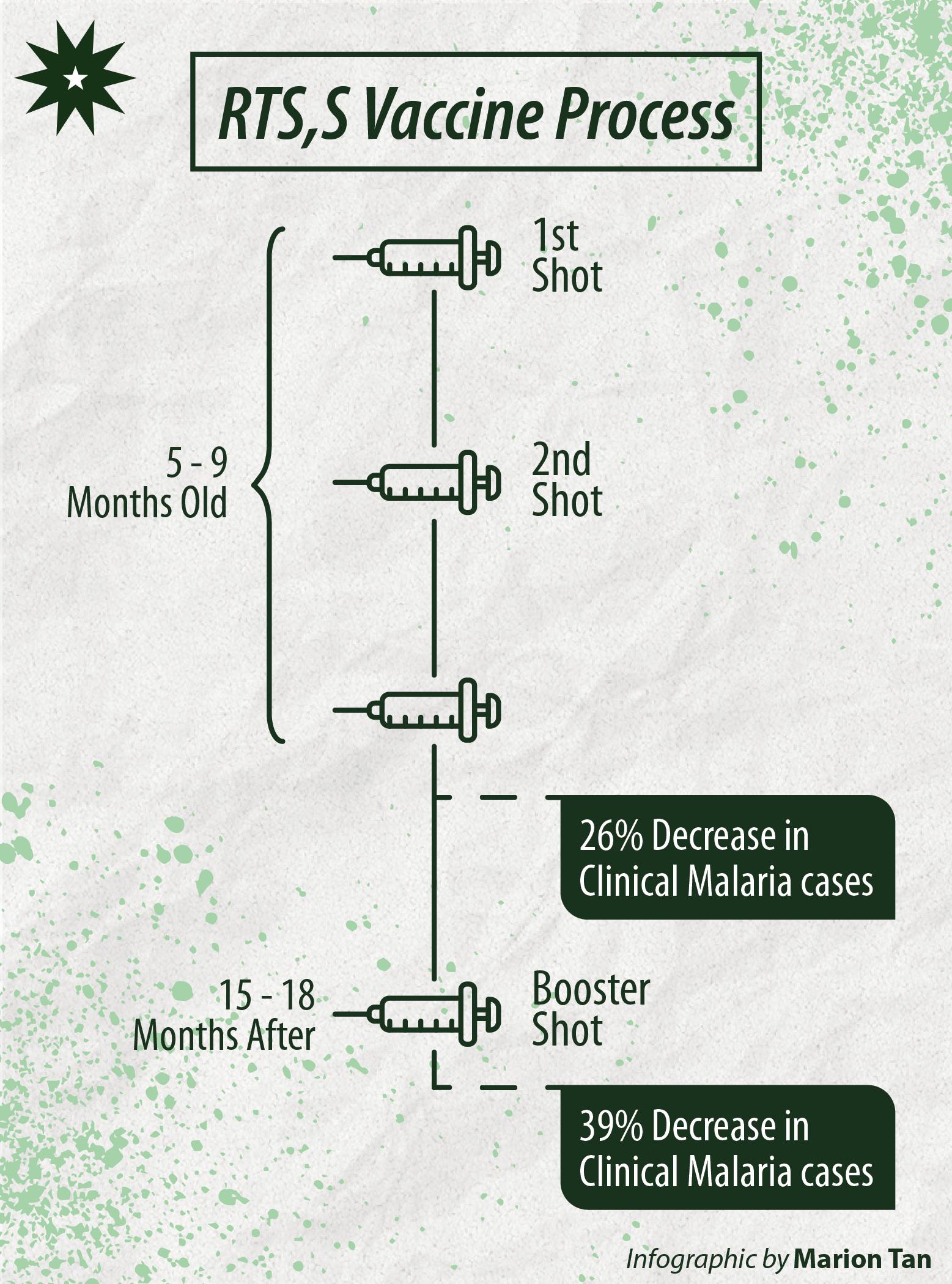Earlier this year, three countries were chosen to pilot-test the first ever malaria vaccine. In a joint project with the World Health Organization (WHO) and GlaxoSmithKline Biologicals (GSK), the program sought to immunize 120,000 children below the age of two. The initiative comes after the vaccine RTS,S/AS01 (RTS,S), also known as Mosquirix, was found to have successfully prevented 40 percent of cases of malaria in clinical trials.
A new beginning
A protein-based antigen (a toxin which helps protect the body from particular infection), the vaccine aims to trigger the body’s immune system to defend against Plasmodium falciparum—the disease-causing parasite. As the parasite enters the bloodstream, the RTS,S’ prevents the parasite from entering the liver where it can fester and lead to the development of the disease.
The vaccine is administered through three primary shots when a child is five to nine months old, and a booster shot 15 to 18 months after. The first round of malaria immunizations transpired on April 23 in Malawi, while Kenya and Ghana followed suit a week after. The program is the world’s first large-scale initiative to immunize children against the said disease.
The RTS,S has been in development for years. In the late 1980s, the vaccine was developed by a team of scientists working at SmithKline Beecham Biologicals (now GSK) and was improved with the help of the Walter Reed Army Institute of Research. It also received funding from the PATH Malaria Vaccine Initiative and the Bill and Melinda Gates Foundation.
Results after the pilot test showed that the vaccine reduced clinical malaria cases among patients who have had the initial three doses by 26 percent, and 39 percent among patients who have completed the four-dose schedule. It was also noted that immunity from malaria waned over time after the fourth dose was administered.
Despite the doubts surrounding RTS,S, the vaccine received a positive medical opinion from the Committee for Medicinal Products for Human Use (CMPH) under the European Medicines Agency. When implemented alongside traditional preventive methods, the vaccine can reduce the risk of getting malaria. In a statement, the CMPH expressed, “Despite its limited efficacy, the benefits of Mosquirix outweigh the risks in both age groups studied.” Upon the release of the statement, WHO recommended RTS,S to be used in large-scale pilot tests in children from five to nine months old in Africa.

Malaria uncovered
According to WHO, the risk of getting infected by malaria is unusually high in sub-saharan Africa, with 92 percent of the global malaria cases identified in the region. The disease, which is caused by the the bite of the female Anopheles mosquito, can induce high fevers, headaches, and chills. If left untreated, these symptoms can worsen into severe illness that may cause death within 24 hours.
The risk of malaria is also high in tropical countries where stagnant pools of water during rainy seasons become breeding grounds for mosquitoes. In previous years, however, the Philippines has seen a significant decrease in malaria cases . Through the efforts of the Department of Health’s (DOH) National Malaria and Control Program, 50 out of 81 provinces in the country are “malaria free”. Though, local transmissions of malaria are still prevalent in areas like Palawan, Sultan Kudarat, Maguindanao, Mindoro Oriental, and Sulu.
The Philippines had one of its worst cases of malaria in 1903 when recorded deaths reached up to approximately 120,000 people out of a population of seven million. But through epidemiological studies—studies which deal with the incidence, distribution, and control of diseases—funded by the Rockefeller Foundation, malaria cases have since been significantly controlled, dropping to approximately 15,000 recorded deaths out of a population of 13 million in 1935.
Malaria is currently being treated in the Philippines through the use of Coartem—a Artemether-Lumefantrine (AL) combination used only to treat Malaria—as first-line treatment as recommended by DOH. In the case of failure of the AL combination, other antimalarial medications may be used such as Quinine—a crystalline compound also used for leg cramps and muscle pain—may be used as second-line treatment with Mefloquine, which is used for early prevention of malaria.
To reduce the risk of getting malaria, doctors recommend using insect repellents to cover the arms and legs and taking oral prophylaxis, especially when going to endemic areas. Doctors also recommend getting an early consultation when malaria symptoms start appearing. It is also important to destroy the breeding places of mosquitoes like stagnant, standing freshwater.
Mosquirix in the Philippines—a possibility?
Once deemed safe and effective, the vaccine can aid the DOH’s vision of a “Malaria-Free Philippines by 2030”. However, due to the recent growth of people refusing to vaccinate their children because of the fear of potential side effects, Dr. Lily Ann H. Cabuling, Director of the University’s Health Services Office, thinks that newer vaccines should only be launched after thorough research. “They should be upfront as to its efficacy, side effects, and vaccination success rates. If people are well-informed, I believe that their doubts [will be] appeased and will [encourage them to] use the vaccine just like how they trust the use of flu and pneumonia vaccines,” Cabuling adds.
While RTS,S is still in its rudimentary stages, there’s no denying the hope it gives to countries that have not yet eradicated malaria. With more testing and proper research on the vaccine, we should finally see the implementation of the vaccine in the whole world, and not long after, the eradication of malaria.
